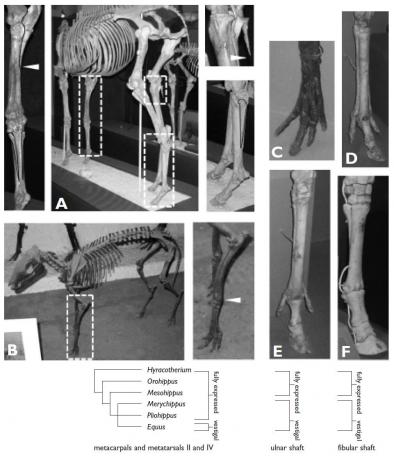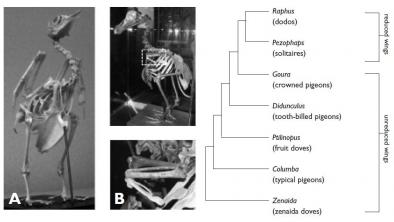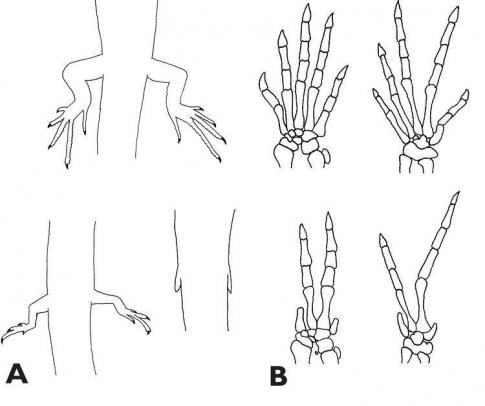INTRODUCTION
A vestigial structure is a rudimentary biological structure that was not rudimentary in the ancestors of its bearer. Such a structure is interpreted by evolutionary biologists as a vestige of a homologous structure that was more fully functional and often larger in the ancestors of the organism in question. Biologists generally consider the existence of vestigial structures one of the main lines of evidence for evolution (Barton and others 2007; Hall and Hallgrimsson 2009). Creationist authors typically argue against the existence of vestigial structures to discredit the idea of evolution (Dewar 1957; Morris 1974; Glover 1988; Bergman and Howe 1990; Bergman 2000; Menton 2000; Sarfati 2002). However, here I show that vestigial structures exist even within the parameters of the creationist worldview, even though creationists go to great lengths to deny their existence and discredit their importance. Vestigial structures are entirely consistent with the creationist worldview and arguments that their absence refutes evolution should be discarded by creationists.
In this discussion, I will examine two predictions derived from the hypothesis that vestigial structures exist. The first prediction is that creationist arguments against the existence of vestigial structures can be refuted. The second prediction is that examples of vestigial structures can be identified even within the creationist paradigm; that is, that examples of vestigial structures can be identified in organisms for which both the putative ancestor and the putative descendant are recognized by creationists as part of the same “created kind” or baramin.
In creationist technical literature, the term “baramin” refers to an organism that was created by God during the Creation Week that is recorded in the first chapter of Genesis, plus all of its descendants (Siegler 1978; Wood 2002, 2006). Creationists recognize that speciation occurs within baramins, so that a given baramin today includes several populations that mainstream biologists regard as separate species (Siegler 1978; Tyler 1997; Robinson and Cavanaugh 1998; Wood 2006). Among closely related species, morphological and/or genetic continuity and the ability to produce hybrid offspring are considered by creationists to demonstrate inclusion in the same baramin (Siegler 1978; Wood 2002, 2006). According to these criteria, most baramins correspond to families in the taxonomic hierarchies of mainstream biology (Robinson and Cavanaugh 1998; Wood 2002, 2006). For example, creationists consider the cat family (Felidae) a single baramin in which all the members — house cats, bobcats, tigers, lions, and so on — are descended from the ancestral cat population that God created during Creation Week (Robinson and Cavanaugh 1998).
REFUTATION OF ARGUMENTS AGAINST THE EXISTENCE OF VESTIGIAL STRUCTURES
By far the most popular creationist argument against the existence of vestigial structures is that many biological structures that were once considered useless are now known to have a function (Dewar 1957; Morris 1974; Bergman and Howe 1990; Bergman 2000; Menton 2000; Sarfati 2002). This argument is invalid, because it confuses vestigiality with uselessness. A rudimentary structure can have a recognizable function and still be considered vestigial if it is demonstrably a remnant of an ancestrally non-rudimentary structure (Isaak 2007). For example, if it is demonstrated that the rudimentary, spur-like hindlimbs of pythons are derived from non-rudimentary hindlimbs in the ancestors of pythons, then python spurs can be considered vestigial hindlimbs, despite the fact that they have a recognizable function: to spear opponents during dominance contests (Barker and others 1979). By the same token, the rudimentary wings of the cassowary can be considered vestigial if it is demonstrated that they are derived from non-rudimentary wings in cassowary ancestors, despite the fact that cassowaries use their rudimentary wings in threat displays (Davies 2002). While it is true that Darwin (1872) assumed that rudimentary structures are useless, modern biologists do not make this assumption and therefore do not employ uselessness as a criterion for recognizing a vestigial structure. Even so, vestigial structures can often be considered useless with respect to the usual function of their non-rudimentary counterparts. For example, python hindlimbs are useless as organs of locomotion, and cassowary wings are useless as organs of flight. This objection by creationists based on the functionality of these vestigial organs therefore arises from a misunderstanding of the concept of vestigiality.
Bergman (2000) argues that a definition of vestigiality based on reduction and not uselessness is meaningless, because biologists do not consider structures vestigial if they have been only slightly reduced. It is correct that biologists do not consider slightly reduced structures vestigial, but Bergman (2000) is incorrect to assume that any degree of reduction is used to label a structure vestigial. Structures are labeled vestigial, based on reduction in size, only if that reduction is extreme. For example, the shortened limbs of a dachshund are not considered vestigial limbs, but the miniscule spurs of a python are. This objection by Bergman (2000) is therefore based on a misunderstanding of the reduction criterion. Bergman (2000) correctly states that the evolutionary history of an organ must be known to determine whether it is vestigial. He then argues against the validity of determinations of vestigiality by claiming that evolutionary histories are not known for most such organs and that their identification as vestigial is based on direct comparison with modern and not fossil examples. That claim shows two errors. First, evolutionary inference does not require direct observation of the history of all structures. Second, the evolutionary histories of vestigial skeletal structures are often well documented by fossil series. For example, in derived tyrannosauroid dinosaurs the third finger is reduced to a metacarpal splint with no phalanges (Lambe 1917), whereas early tyrannosauroids had a complete third finger; the fossil record therefore sufficiently documents the evolutionary history of the tyrannosauroid third finger to determine that in derived tyrannosauroids it is vestigial (Xu and others 2004). This objection by Bergman (2000) is based on the incorrect assumption that fossil series are not used to determine vestigiality.
The above objection by Bergman (2000) is invalid for another reason. In evolutionary studies, a precursor to a rudimentary organ can be deduced by comparison with its non-rudimentary counterparts in close relatives. By the same token, within the creationist paradigm a rudimentary structure in one species must be considered vestigial if the homologous structure is non-rudimentary in other species within the same baramin. In such a case, even a creationist must concede that a rudimentary structure has evolved from a non-rudimentary homolog.
Darwin (1872) and others explain that a biological structure may become vestigial if members of the evolutionary lineage in question stop using it. Some creationists claim that this explanation is Lamarckian and therefore false (see Glover 1988; Bergman and Howe 1990). The term Lamarckian refers to the now-discredited hypothesis, named after the pre-Darwinian biologist Jean-Baptiste Lamarck, that traits acquired by an organism during its lifetime are heritable. An example of a Lamarckian scenario is one in which an organism does not exercise a certain muscle, which then atrophies due to disuse, and the organism’s offspring then inherit an atrophied version of that muscle. Lamarckian scenarios are unrealistic, as witness the fact that the children of amputees are born with their limbs intact. But the creationists’ objection that the disuse explanation of vestigiality is Lamarckian is based on a misinterpretation of the evolutionary scenario described by Darwin and others, which is in fact not Lamarckian. The misinterpretation is understandable, because the evolutionary scenario in question is often described with poor wording, as in the first sentence of this paragraph. This scenario could be better worded thus: if members of an evolutionary lineage cease to use a given organ, then the survival of the lineage will not be compromised if one of its members is born with a heritable mutation that results in the reduction of that organ to a rudimentary state; the descendants of that individual will possess a vestigial organ. This is not a Lamarckian scenario, and the objection that it is one is therefore false. Neither Darwin (1872) nor any modern evolutionary biologist makes the Lamarckian claim that atrophy of an organ due to disuse (for example, withering of a muscle that an individual does not exercise) is heritable.
EXAMPLES OF VESTIGIAL STRUCTURES
Clearly, the creationist arguments against the existence of vestigial structures are based on misunderstandings and incorrect assumptions. Even so, these examples of vestigial structures do not necessarily demonstrate that vestigial structures exist within the creationist paradigm, because they relate to taxa that creationist authors have not identified as belonging to a single baramin. Baraminologists (creationist researchers who seek to determine which extant taxa belong to which baramins) have not placed pythons in the same baramin as any fully legged animal, and they have not yet studied cassowaries or tyrannosauroids.
However, examples of vestigial structures do exist within baramins that have been studied by and are recognized by baraminologists. The fossil horse series offers some examples. Creationists once considered fossil members of Equidae (the horse family) to have been created separately from modern horses (Cousins 1971; Gish 1973). However, recent baraminological studies confirm that there is too much morphological continuity between the various fossil and extant members of Equidae to support that interpretation (Garner 1998; Cavanaugh and others 2003; Wood 2005). Today’s creationists therefore consider the fossil horse series a real example of evolution within a single baramin (Garner 1998; Cavanaugh and others 2003; Wood 2005). The fossil record reveals that in the earliest equids each forelimb had four digits, each hindlimb had three digits, the shaft of the ulna extended the full length of the forearm, and the shaft of the fibula extended the full length of the shank (Figure 1). In each forelimb and hindlimb of later fossil equids all digits but number III were lost, and in modern horses thin splints of bone are all that remain of the metacarpal (hand) and metatarsal (foot) bones that supported digits II and IV in each limb. The shafts of the ulna (inner bone of the lower arm) and fibula (outer bone of the lower leg) were progressively reduced in the horse lineage, and in today’s equids they are reduced to tiny spikes (Marsh 1879) (Figure 1). The metacarpal and metatarsal splints of modern equids are vestigial bones, and the ulnar and fibular splints are vestigial shafts of bones. Because these rudimentary skeletal structures are demonstrably derived from non-rudimentary structures in ancestral members of the same baramin, they must be considered vestigial within the creationist paradigm.
It should be noted that these vestigial skeletal structures perform useful functions in extant horses, and that they are nonetheless vestigial. The metacarpal and metatarsal splints serve as guides for ligaments, and remnants of the ulna and fibula function as muscle attachment sites (Smythe 1967). Even so, these structures are vestigial because they currently exist in a state of extreme reduction and they are derived from non-rudimentary homologs in ancestral equids.
Other cases exist in which the vestigiality of a structure can be deduced by comparison with close relatives without reference to fossils. For example, the family Columbidae includes flying pigeons and doves with unreduced wings, as well as flightless dodos and solitaires with miniscule wings (Figure 2). The family Columbidae is identified by creationists as a single baramin (More 1998), and molecular phylogenetic analysis confirms that the dodo and solitaire are phylogenetically nested deeply within the family and are descended from flying columbid ancestors (Shapiro and others 2009). Therefore, the extremely reduced wings of dodos and solitaires are derived from the flying wings of ancestral columbids and so must be considered vestigial within the creationist paradigm.
In some cases, a single genus contains some species with an unreduced version of a given structure as well as species with a vestigial version. The cave salamanders Eurycea rathbuni and Eurycea tridentifera have strongly reduced, nonfunctional eyes, while other species of the genus Eurycea that do not live in caves have unreduced, functional eyes (Petranka 1998). In some species of the Australian lizard genus Hemiergis the forelimb and hindlimb both have five full digits, while in other species the outer digits are reduced to metacarpal and metatarsal splints with no finger bones (Choquenot and Greer 1989) (Figure 3B). Within the African lizard genus Tetradactylus is a morphologically continuous series of species of which some possess complete, unreduced limbs; some possess limbs that are drastically reduced nubs without digits; and others have lost the limbs altogether (Berger-Dell’mour 1985) (Figure 3A). Within the African lizard genus Scelotes is another series of species with a similar spectrum of degrees of limb loss (Branch 1998; Whiting and others 2003), and the same is true for the Australian lizard genus Lerista (Greer 1990). No baraminological study has yet been carried out on Eurycea, Hemiergis, Tetradactylus, Scelotes, or Lerista, but because recognized baramins usually correspond to taxa above the genus level (Robinson and Cavanaugh 1998; Wood 2002, 2006) it is doubtful that today any creationist would place members of the same genus in different baramins. Therefore, within the creationist paradigm the eyes of E rathbuni and E tridentifera are vestigial, as are the reduced fingers of the relevant members of Hemiergis and the extremely reduced limbs of the relevant members of Tetradactylus, Scelotes, and Lerista.
CONCLUSION AND DISCUSSION
All objections to the existence of vestigial organs are demonstrably invalid, and there are numerous examples of vestigial structures within groups of organisms recognized by creationists as baramins. Thus there is no evidence to falsify the predictions of the hypothesis that vestigial structures exist within the creationist paradigm.
Creationist authors have long maintained that heritable change and speciation occur within baramins (Siegler 1978; Robinson and Cavanaugh 1998; Wood 2002, 2006). Here I have shown that this process sometimes gives rise to incontrovertibly vestigial structures and that their existence is consistent with the creationist paradigm. Creationists should therefore cease to claim that vestigial structures do not exist. That claim should be removed from the arsenal of anti-evolution arguments, because even within the creationist paradigm it is false.



